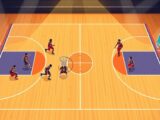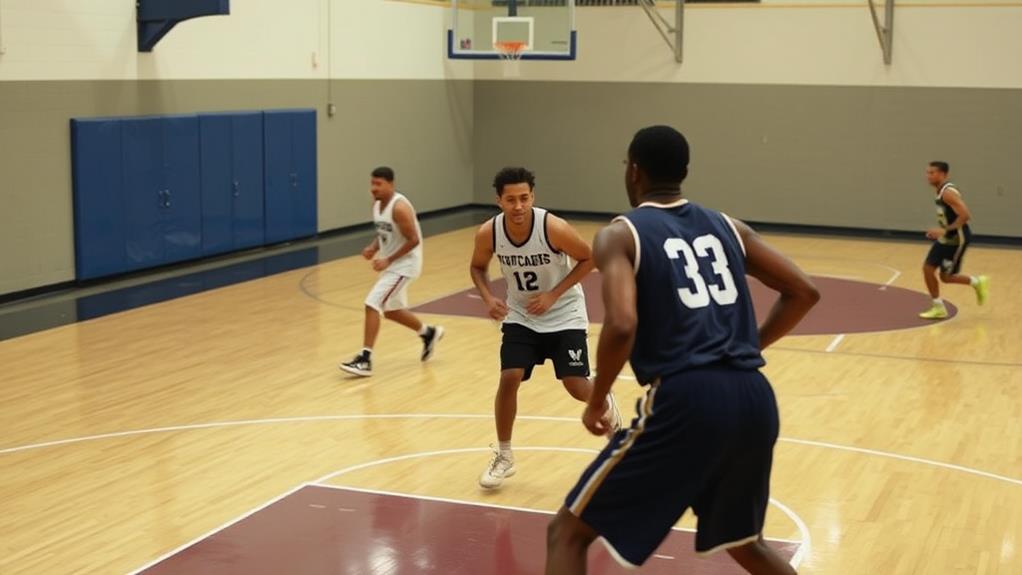
What Is an Illegal Screen in Basketball and How to Avoid It
September 15, 2024An illegal screen in basketball happens when you move or crowd a defender's space, leading to an offensive foul. To avoid this, you need to stay stationary and keep your feet shoulder-width apart. Make sure you don't extend body parts outside your vertical plane, as it hinders the defender's movement. Providing one to two steps of space allows defenders to navigate around you. Effective communication with your teammates and timing are key, preventing turnovers that can disrupt your game. There's much more to mastering clean screens and enhancing your offense that you'll want to understand.
Definition of Illegal Screen
An illegal screen in basketball occurs when the offensive player setting the screen breaks the rules by either moving or not giving enough space for the defender to maneuver around.
To set a legal screen, you need to remain stationary and maintain a shoulder-width stance until contact is made with the defender. Proper positioning and understanding of data analytics can also help players refine their screening techniques. If you extend your body parts outside the vertical plane while setting the screen, it constitutes an illegal screen.
To avoid the screen, the defender must have at least one step of space to navigate around you. If you crowd that space or move into the defender's path, you risk committing an offensive foul.
It's essential to be aware of your positioning and the defender's movement. Frequent illegal screens can lead to turnovers, disrupting your team's flow and giving possession to the other side.
Penalty for Illegal Screen
When you commit an illegal screen, it results in an offensive foul, costing your team possession of the ball. This turnover can shift the game's momentum in favor of your opponents.
Understanding the nuances of defensive strategies, such as the emphasis on effective communication, can help teams mitigate the risk of illegal screens.
Referees are quick to signal these infractions, so it's crucial to understand the consequences and avoid penalties that disrupt your offensive strategies.
Consequences of Illegal Screens
Illegal screens carry significant consequences that can impact the flow of a basketball game. When you set an illegal screen, you risk being charged with an offensive foul. This not only results in a turnover for your team, but it also hands possession of the ball to your opponents. They'll then have a prime opportunity to score, putting your team at a disadvantage.
Understanding the consequences of illegal screens is vital for maintaining your offensive strategy. If players frequently commit this infraction, it can lead to a negative reputation, affecting your performance and the overall dynamics of the team. You definitely want to avoid setting illegal screens, as they disrupt not just individual plays but the game's rhythm as a whole.
Additionally, referees will signal the infraction, ensuring that the rules are enforced and the integrity of the game is maintained. By staying aware of the potential penalties and the effects on your team, you can strategize better and enhance your gameplay.
Avoiding illegal screens is essential, so focus on proper technique and positioning to keep your team in the game.
Referee Signaling Infractions
Understanding how referees signal infractions is essential for players and teams alike, especially regarding the penalty for an illegal screen. When a screener commits an illegal screen in basketball, the referee calls an offensive foul, clearly indicating that an infraction has occurred during play. This call results in a loss of possession of the ball for the offensive team, leading to a turnover awarded to the opposing team.
Referees closely monitor the positioning and movement of the screener, ensuring compliance with the vertical plane and maintaining adequate distance from defenders. By doing so, they uphold the integrity of the game and enforce the rules effectively.
Recognizing how referee signaling infractions work helps players adjust their strategies and avoid unnecessary penalties. Awareness of the potential penalties associated with illegal screens is vital for teams.
Vertical Plane Requirements
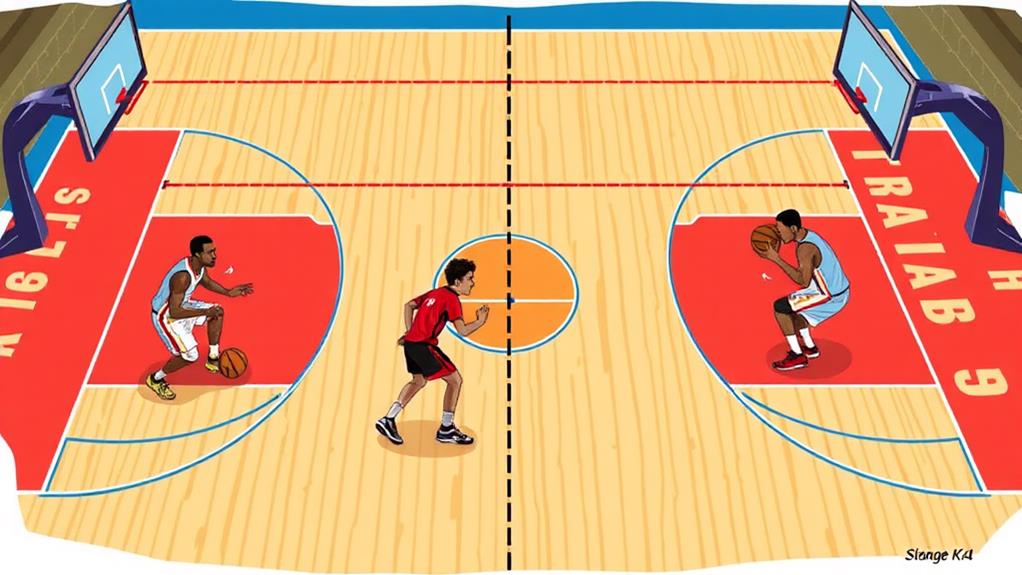
To set a legal screen, you need to maintain a shoulder-width stance, which is vital for keeping your body within the vertical plane.
Proper positioning and awareness of your surroundings are essential in ensuring compliance with the rules, much like how players must adhere to field dimensions and equipment requirements.
Staying stationary until contact is made is essential; any movement can lead to an illegal screen.
Shoulder-width Stance Importance
Maintaining a shoulder-width stance is essential for a screener to achieve balance and stability while ensuring a legal position on the court. When you're a player setting a screen, keeping your feet shoulder width apart helps you stay grounded and minimizes the risk of illegal screens. This stance allows your knees to bend slightly, giving you better control over your body and positioning.
The vertical plane surrounding you requires that you remain within an imaginary cylinder, so extending your arms or legs could lead to illegal contact. By keeping your stance shoulder-width, you avoid leaning or shifting your weight into defenders, which is a common cause of illegal screen calls. This positioning not only protects you from penalties but also provides adequate space for defenders to maneuver around the screen.
To maintain balance and stability, focus on your foot placement and body alignment. A solid shoulder-width stance will enhance your effectiveness as a screener, allowing you to set screens without risking fouls.
Maintaining Stationary Position
A solid shoulder-width stance sets the foundation for a screener to maintain a stationary position, which is essential for executing a legal screen. To achieve this, keep both feet grounded on the floor, ensuring you don't lean or extend your legs outside your vertical plane.
This vertical plane is shaped by your shoulders, arms, and legs, and staying within it is vital to avoid penalties for illegal screens.
As you prepare to set the screen, remember that you're responsible for providing enough space—typically one to two steps—for the defender to maneuver around your position. If you invade this space, you increase the likelihood of being called for an illegal screen.
Using a jump stop technique can help you achieve that balanced, stationary position. This technique allows you to settle into your stance without shifting your weight or moving your feet, which minimizes the risk of being penalized.
Focus on maintaining that strong, stationary presence as you set the screen, and you'll effectively set your teammate up for success while avoiding the pitfalls of an illegal screen.
Time and Distance Considerations
When setting a screen in basketball, understanding time and distance is fundamental for avoiding an illegal screen call. The screener must provide the defender with adequate time and distance, typically one to two steps, to navigate around the screen without making contact.
If the defender is moving quickly, you need to adjust your positioning and timing accordingly. This way, you guarantee that the defender has enough space to maneuver, minimizing the risk of an illegal screen being called.
Maintaining awareness of the defender's position is essential. You should be able to gauge how fast they're approaching and adjust your hold on the position to avoid any unnecessary contact.
Effective communication with the ball handler also plays a critical role. Timing the screen execution together helps you both minimize the chance of a turnover due to an illegal screen.
Moving Screen Explanation
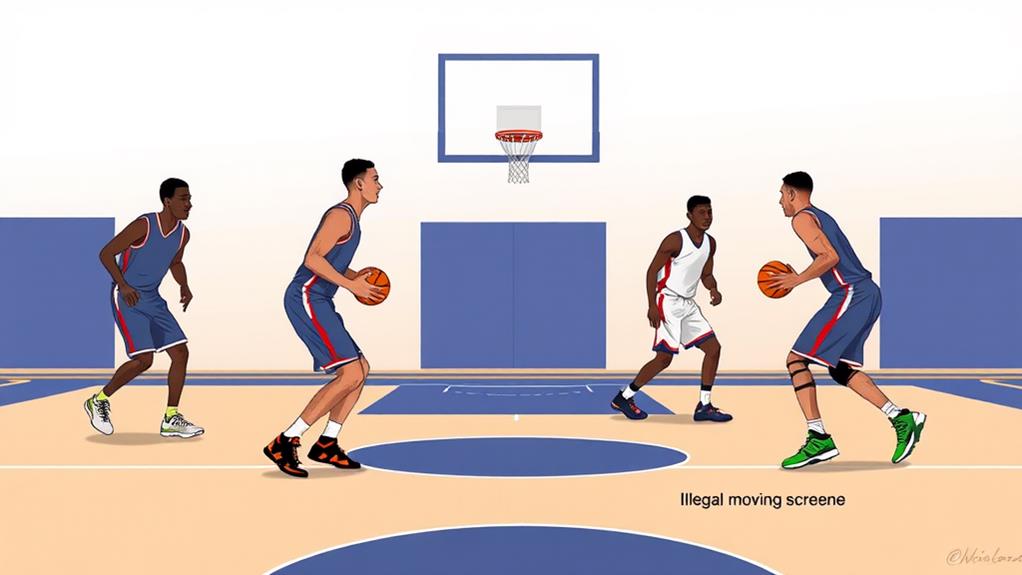
Setting a moving screen can quickly lead to an offensive foul if you're not careful. A moving screen occurs when you, as the screener, fail to maintain a stationary position while the screen is set, resulting in contact with a defender. To avoid this, keep your feet planted and within a shoulder-width stance during the setup, as enhanced equipment contributes to improved athletic performance lightweight design.
If you shift your position or move into the defender, that's classified as an illegal screen, and it'll cost your team a foul. You can adjust your feet to reposition after the initial contact, but you must still allow enough time and distance for the defender to navigate around the screen.
Being aware of the defender's movement is essential. If the defender is in motion, wait until they're set before establishing the screen. This way, you reduce the risk of an illegal screen and maintain your team's offensive flow.
Strategies to Avoid Illegal Screens
To minimize the risk of committing illegal screens, focus on maintaining a stationary position and being aware of your surroundings. As a player setting the screen, you should prioritize keeping your feet shoulder-width apart and your knees slightly bent to stay within the vertical plane. This helps guarantee you're in a legal position for the screen.
Additionally, understanding key regulations in basketball can enhance your gameplay and reduce the chances of fouls, making it essential to familiarize yourself with key regulations.
Here are some strategies to keep in mind:
- Give the defender enough time and space to maneuver around the screen, usually one to two steps.
- Avoid extending any body parts outside the imaginary cylinder around you, since movement can lead to illegal screens.
- Communicate clearly with your teammates using both visual and verbal cues to synchronize the screen with the ball handler's movements.
- Stay away from setting screens in out-of-bounds areas, which raises the likelihood of violations.
- Always be aware of the ball handler's position to guarantee timing and effectiveness.
Teaching Clean Screening Techniques
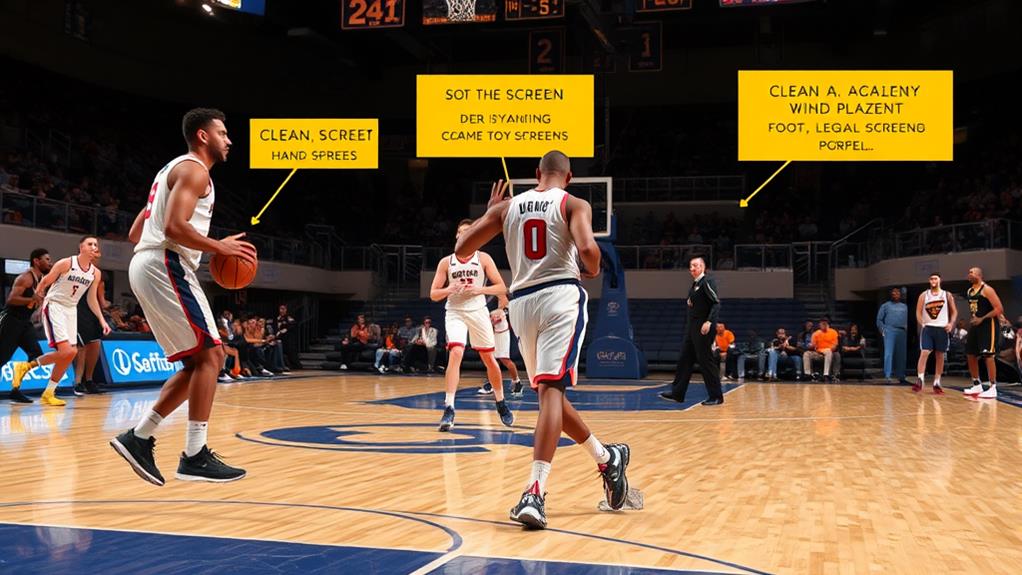
Clean screening techniques are essential for players who want to excel on the court without drawing fouls. Start by positioning your feet shoulder-width apart, maintaining a balanced stance with your knees slightly bent. This setup helps guarantee a legal screen position. Remember, you should remain stationary until contact is made. This gives defenders enough time to avoid the screen without being physically obstructed.
Incorporating fundamental principles of defense, such as maintaining compactness, helps reinforce your positioning during screens. Learn the jump stop technique to establish a firm position before you set a screen. This minimizes the risk of illegal moving screen violations.
While setting screens, avoid using your elbows or excessive body contact; this keeps your play clean and maintains your reputation, helping you avoid penalties.
Incorporate drills focusing on proper positioning and communication between you and the ball handler. This enhances awareness and timing during screen executions.
Practicing these clean screening techniques won't only improve your effectiveness on the court but also reduce the likelihood of committing illegal screen fouls. By mastering these fundamentals, you'll contribute positively to your team's offensive play without risking unnecessary turnovers or fouls.
Importance of Screens in Offense
Utilizing screens effectively can transform an offense, creating vital opportunities for players to break free from defenders. Screens play a pivotal role in generating open shots and driving lanes, allowing offensive players to exploit defensive weaknesses.
As basketball has evolved, the strategic use of screens has become even more important, especially with the rise of advancements in offensive strategies that emphasize spacing and player movement. When you implement on-ball and off-ball screens strategically, you can create favorable matchups that disrupt defensive assignments and lead to confusion.
Here are some key reasons why screens are important in offense:
- Separation: Screens create space between players and their defenders.
- Fluidity: Effective screen execution enhances the overall flow of the offense.
- Scoring Efficiency: Teams using well-timed screens often see improved scoring statistics.
- Defensive Disruption: Screens can confuse defenders and lead to mismatches.
- Open Opportunities: They facilitate open shots for shooters and driving lanes for slashers.
Incorporating screens into your offensive strategy isn't just about making plays; it's about maximizing your team's potential.
Understanding how to utilize screens while avoiding illegal screens guarantees you can capitalize on every opportunity to score. Ultimately, mastering this aspect can elevate your game and contribute to your team's success on the court.
Illegal Screens in the NBA
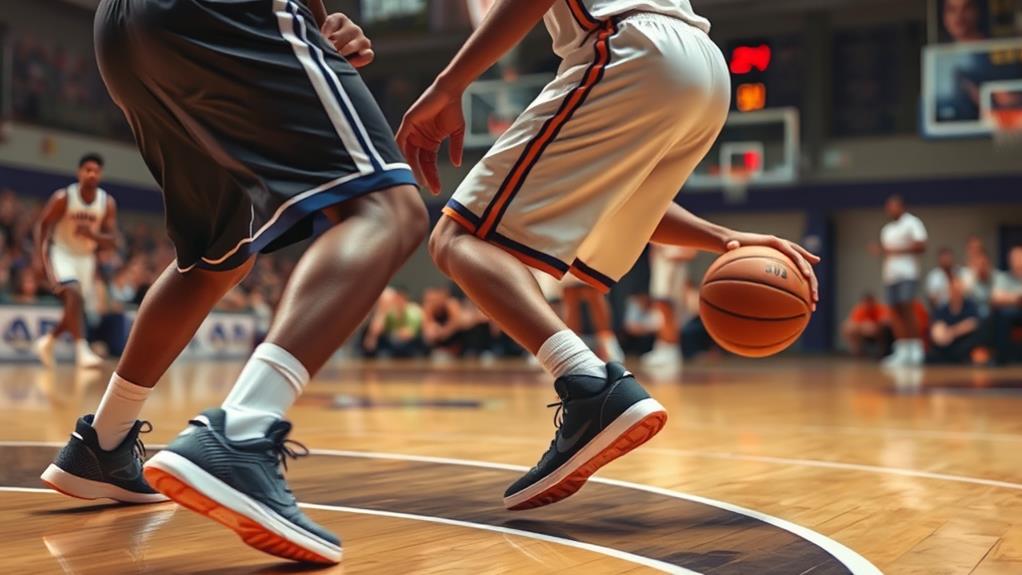
Illegal screens in the NBA can quickly turn a promising offensive play into a turnover, disrupting the rhythm of the game. When you set an on-ball screen or an off-ball screen, you need to maintain a shoulder-width stance and stay stationary. If you move or fail to give the defender adequate space, you risk getting called for an illegal screen, resulting in an offensive foul.
Centers play a significant role in this aspect, as their ability to set effective screens can create substantial scoring opportunities for the team and maintain offensive flow, contributing to their overall defensive impact and rim protection.
Referees are trained to spot these borderline illegal screens, especially in the fast-paced environment of the NBA. They know how important it's to keep the game flowing, but they also prioritize player safety. So, you must be aware of your surroundings and the field of vision of the defenders as you set your screens.
Players like Rudy Gobert excel in this area, known for their clean, legal screens that help create scoring opportunities for their teammates. The league even tracks "screen assists" to measure how effectively players contribute through screening.
Conclusion
In basketball, understanding and avoiding illegal screens is essential for maintaining your team's flow and effectiveness. Remember, "practice makes perfect." By mastering clean screening techniques and being aware of your positioning, you can contribute positively to your offense without drawing fouls. Keep an eye on your vertical plane and maintain the right distance from defenders, and you'll help your team thrive on the court. Embrace the art of screening, and watch your game elevate!

